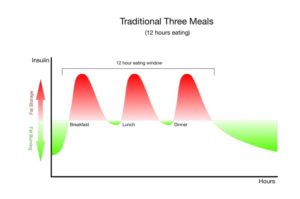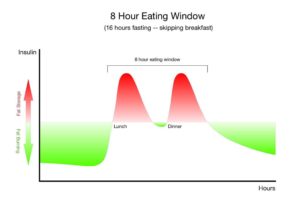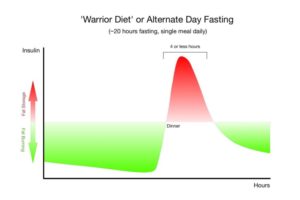Several books I read mentioned “intermittent fasting” (Wahls protocol, Bulletproof, Cancer as a Metabolic Disease). But I didn’t like fasting and I thought I would get tired if I fasted (it would slow down my metabolism) I finally decided to try it and it is not hard to skip breakfast when you eat a keto diet! Now, I generally skip breakfast and have first cup of coffee with cream and MCT oil at around 9:00 a.m. It takes time to lower insulin – but my fasting insulin is now between 3-7.
Dr Wahls pg 209-210: “your mitochondria will thrive if you eat just twice a day and fast for 12-16 hours between your evening meal and your morning meal…it leads to increased efficiency in your mitochondria and encourages your cells to produce more mitochondria per cell…and there is a nerve growth hormone generated by fasting, which stimulate brain cell growth and additional brain cells connections.”
Fasting is very different from eating fewer calories. When a person just lowers their calories, their metabolism slows down. But, during fasting, the metabolism does NOT slow down!
https://intensivedietarymanagement.com/fasting-and-lipolysis-part-4/
Low carb is great for preventing insulin spikes, but fasting is amazing for lowering overall “fasting insulin” level. It is a one two punch to have low carb most the time and not eat breakfast or fast several days per week (you might try one of the intermittent fasting types below).
One scientist who has been studying fasting for many years is Professor Valter Longo, the director of the University of Southern California’s Longevity Institute. Another is Dr. Jason Fung.
Fasting lowers levels of IGF-1 and also appears to switch on a number of DNA repair genes.
Fasting reduces insulin and insulin resistance. If a person fasts intermittently the insulin level continues to drop for about 6 months. After 6 months, the insulin level is about 30% lower than it was. Blue line is Insulin level with intermittent fasting. Red is the insulin level if you just lower your calories but continue to eat often.
In the charts and options below, you are striving for the green part of the chart – that is where your insulin is low because you have not eaten.
12 hour fasting (below) – There are several regimens of fasting that use a shorter period of fasting but done every day. A 12 hour fasting period done every day used to be ‘normal’ in the 1960’s. Everyone would eat 3 meals a day from, say 7 am to 7 pm, not snack much and not eat anything from 7 pm to 7 am.

16 hour fasting (below)– This regimen involves using a daily 16 hour period of fasting and an 8 hour ‘eating window’. For example, this would mean you fast from 7 pm to 11am. This generally means skipping the morning meal every day. Some people choose to eat 2 meals during that 8 hour window and others will eat 3.

20 hour fast (below) – all meals are eaten during a 4 hour window. The benefit of this type of fast rather than 24 hours is that a person could still have their medications with a meal.

24 hour fast – could have dinner on one day and then fast until the next day at dinner. This also allows a person to take medications with food.
longer fasts require medical supervision if a person is taking any type of medication. Children, teenagers & pregnant or nursing mothers should NOT fast!
Tips:
- The BEST fast is the one you can fit into your regular lifestyle and maintain, because this is a lifestyle change, not a one time deal. Longer fasts work more quickly, but a 16-24 hour fast is VERY effective at lowering insulin.
- You can drink bone broth with sea salt, water, coffee and all types of tea – sodium helps to avoid becoming dehydrated.
- It is OK to have coffee with 1 tsp of cream and coconut oil or MCT oil and still be in fast. (not more cream because milk protein will stimulate insulin which defeats the point of fasting)
- Can have 2 T Apple Cider Vinegar in water. If you have it before bed, your waking blood glucose will be lower
- Do not eat Whey powder (ever). It is a highly processed chemical not a real food and it stimulates insulin.
- Do not need to take multi vitamin when fasting
- when break a longer fast, have a handful of nuts or salad 30 min before main meal
- Children, teenagers and pregnant or nursing women should not fast!
Insulin & how to lower insulin
- A low carb diet will keep body from insulin spikes.
- 45-50% of the insulin your body makes is called “basal insulin” or “fasting insulin” – this is the lowest level of insulin in body.
- fat people have higher fasting insulin and it keeps them fat – their insulin will rise more after eating the exact same food than a thin.
- fat around the stomach is a sign of high insulin – lower your insulin & you will lose much of your belly fat. I have never lost all my belly fat – 🙂
- whatever your fasting insulin level, it will go up 5-7 x within 60 min after eating. Diabetics insulin spikes 2 hours after eating.
- The trick to lowering your fasting insulin is to get insulin as low as possible as often as possible – fasting is the best way to do this.
- People who fasted every other day for 22 days became 57% more sensitive to insulin
- lower stress – Cortisol- from stress and lack of sleep increases insulin. You can reduce cortisol levels (stress) by prayer, a walk, relaxation exercises and even a 10-30 min nap every afternoon
- lower carbohydrate & animal protein consumption: Refined grains and sugars tend to increase insulin the most. Animal protein will also increase insulin
- There are almost no drugs that will lower insulin – fasting even just skipping breakfast a few days per week is the way to lowers insulin.
- Vinegar and fiber help protect against the rise in insulin. This is why subtracting fiber from total carbohydrates to get net carbs is good.
- Fasting is the most efficient and consistent strategy to decrease insulin levels
- Ketones are produced by the body when insulin levels are low.
- Do not drink alcohol when trying to fast or stay in ketosis because the body burns alcohol for fuel- which stops ketosis and basically means you didn’t fast.
- The key to prevention of insulin resistance is to periodically sustain very low levels of insulin…Fasting is one of the most ancient healing traditions in human history
- Hippocrates of Cos (c 460 – c370 BC) is widely considered the father of modern medicine. Among the treatments that he prescribed and championed was the practice of fasting, and the consumption of apple cider vinegar.
- Regular fasting not only lowers insulin levels, it has been shown to improve insulin sensitivity significantly.
- If you have insulin resistance, it keeps the insulin level high – creating a “set point” where you can not lose weight below that level. But, fasting can help get a lower “set point”
